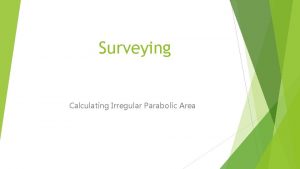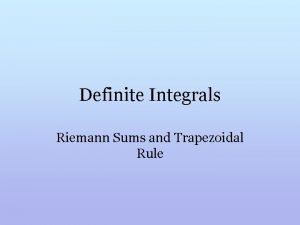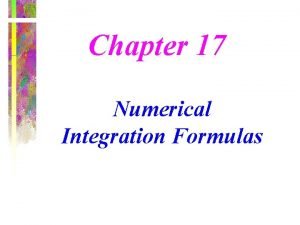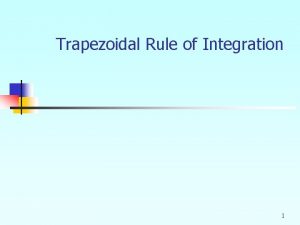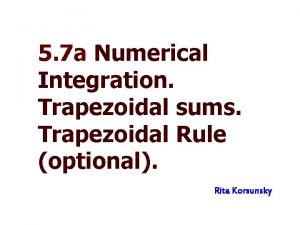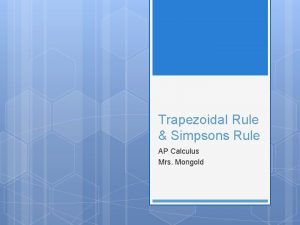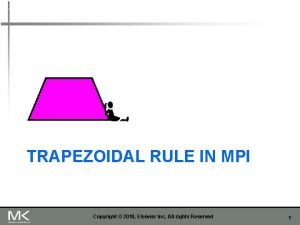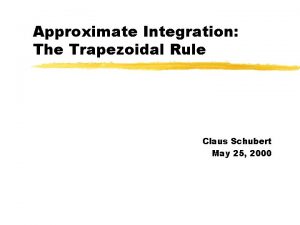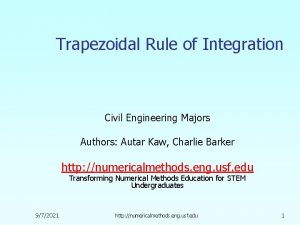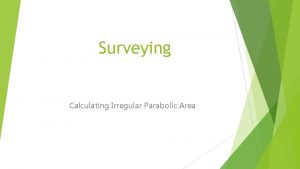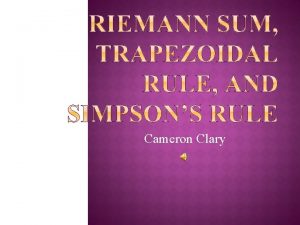5 5 The Trapezoidal Rule I Trapezoidal Rule






![C. Theorem: The Trapezoidal Rule To approximate using trapezoids Where [a, b] is partitioned C. Theorem: The Trapezoidal Rule To approximate using trapezoids Where [a, b] is partitioned](https://slidetodoc.com/presentation_image_h2/1486e5d5abf3f929499073a1ae90c04f/image-7.jpg)









- Slides: 16

5. 5 The Trapezoidal Rule

I. Trapezoidal Rule A. ) Area of a Trapezoid -

B. ) Approximate the area under the following curve from x = 1 to x = 4 using 6 subintervals of trapezoids.

VISUALLY:

TRAM:

TRAM:
![C Theorem The Trapezoidal Rule To approximate using trapezoids Where a b is partitioned C. Theorem: The Trapezoidal Rule To approximate using trapezoids Where [a, b] is partitioned](https://slidetodoc.com/presentation_image_h2/1486e5d5abf3f929499073a1ae90c04f/image-7.jpg)
C. Theorem: The Trapezoidal Rule To approximate using trapezoids Where [a, b] is partitioned into n subintervals equal length

D. Using the Calculator:

II. Examples 1. Use 5 trapezoids to approximate the area bounded by the curve of , the x-axis, and the vertical lines x = 0 and x = 5. Write out each term of the summation and confirm on your calculator.

Visually:


2. The table shows the velocity of a car traveling on a highway at different times. Use TRAM to estimate the total distance traveled over the time interval. t(sec) 0 10 20 30 40 50 60 70 80 v(t) (ft/sec) 0 25 45 60 75 65 60 65 50

3. The table shows the reading of outdoor temperatures from noon to midnight for a certain day. Estimate the average temperature for the 12 hour interval using the trapezoidal rule. Time 12 PM 1 2 3 4 5 6 7 8 9 10 11 12 AM Temp 65 66 68 70 69 68 68 65 64 62 58 55 63


II. Simpson’s Rule Given a nonnegative function f (x), i. e. , f (x) > 0, on [a, b]. Find the area bounded by the curve, the xaxis, and the vertical lines x = a and x = b.

II. Simpson’s Rule Given a nonnegative function f (x), i. e. , f (x) > 0, on [a, b]. Find the area bounded by the curve, the xaxis, and the vertical lines x = a and x = b.
 Trapezoidal rule in surveying
Trapezoidal rule in surveying Trapezoidal rule riemann sum
Trapezoidal rule riemann sum Simpson 1/3 rule
Simpson 1/3 rule Trapezoidal riemann sum
Trapezoidal riemann sum Application of trapezoidal rule in engineering
Application of trapezoidal rule in engineering Trapezium rule
Trapezium rule Chúa yêu trần thế alleluia
Chúa yêu trần thế alleluia Quá trình desamine hóa có thể tạo ra
Quá trình desamine hóa có thể tạo ra Công thức tính độ biến thiên đông lượng
Công thức tính độ biến thiên đông lượng Sự nuôi và dạy con của hươu
Sự nuôi và dạy con của hươu Thế nào là mạng điện lắp đặt kiểu nổi
Thế nào là mạng điện lắp đặt kiểu nổi Dạng đột biến một nhiễm là
Dạng đột biến một nhiễm là Biện pháp chống mỏi cơ
Biện pháp chống mỏi cơ Vẽ hình chiếu đứng bằng cạnh của vật thể
Vẽ hình chiếu đứng bằng cạnh của vật thể Tỉ lệ cơ thể trẻ em
Tỉ lệ cơ thể trẻ em độ dài liên kết
độ dài liên kết Thiếu nhi thế giới liên hoan
Thiếu nhi thế giới liên hoan
